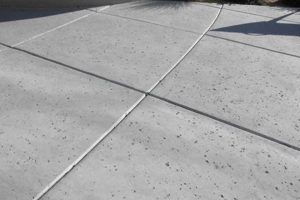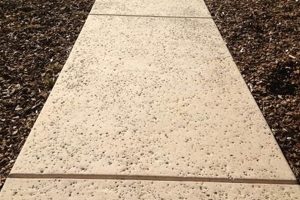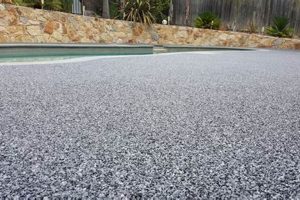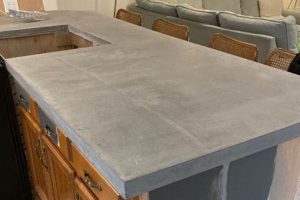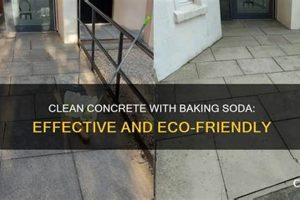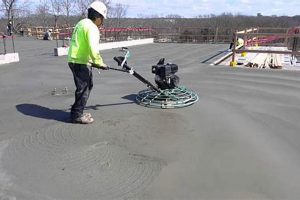Equipment employed to refine the surface of freshly placed cementitious mixtures is essential for achieving desired aesthetics and functional properties. This equipment ranges from simple hand tools like floats and edgers to powered machinery such as trowel machines and grinders. The specific instruments selected depend on the scale of the project, the intended texture, and the performance requirements of the hardened material.
Proper surface refinement provides several advantages, including increased durability, reduced permeability, and improved appearance. Historically, these processes were entirely manual, requiring significant labor and time. Modern advancements in equipment technology have streamlined workflows, enhanced precision, and expanded the range of achievable surface treatments. The utilization of appropriate implements directly impacts the longevity and serviceability of concrete structures.
The subsequent sections will delve into various types of equipment, outlining their applications, operational techniques, and maintenance requirements. Emphasis will be placed on understanding the principles behind their effective use and the potential consequences of improper implementation. Furthermore, safety considerations associated with their operation will be addressed to promote responsible and efficient construction practices.
Essential Techniques for Surface Refinement
Effective utilization of implements ensures a high-quality final product. The following tips offer guidance on optimizing performance and achieving superior results.
Tip 1: Pre-planning is Crucial: Prior to placement, assess environmental conditions, material properties, and desired finish. This assessment dictates implement selection and working methods. For example, hot weather necessitates expedited finishing to prevent premature setting.
Tip 2: Timing is Paramount: Commence operations when the surface water sheen has dissipated, but the material remains workable. Premature working can trap bleed water, weakening the surface. Delayed working results in difficulty achieving the desired texture.
Tip 3: Employ a Systematic Approach: Establish a defined sequence for refining procedures, typically progressing from floating to edging and then troweling. Maintaining a consistent pattern avoids unevenness and ensures uniform compaction.
Tip 4: Implement Proper Overlap: When using powered machinery, ensure sufficient overlap on each pass. This prevents ridges and inconsistencies. A minimum overlap of 25% is generally recommended for trowel machines.
Tip 5: Maintain Equipment: Regularly inspect and maintain equipment to ensure optimal performance and operator safety. Clean implements after each use to prevent material buildup and corrosion. Replace worn blades or floats promptly.
Tip 6: Adjust Techniques to Material: Different mix designs require variations in working methods. High-cement mixtures may require less aggressive floating, while fiber-reinforced mixtures may necessitate specialized edging techniques.
Tip 7: Consider Environmental Factors: Wind and direct sunlight accelerate surface drying, potentially leading to cracking. Implement windbreaks or shading as needed. Employ evaporation retardants to maintain surface moisture during critical periods.
Tip 8: Prioritize Safety: Always adhere to safety protocols when operating powered machinery. Wear appropriate personal protective equipment, including eye protection, gloves, and safety footwear. Ensure adequate ventilation in enclosed spaces.
Mastering these techniques maximizes the potential of implements, producing surfaces that exhibit enhanced durability, aesthetics, and functionality. Consistent application of these principles contributes to the long-term success of concrete projects.
The subsequent sections will explore common challenges encountered during surface refinement and strategies for addressing them effectively.
1. Float characteristics
The characteristics of floats significantly influence the outcome of concrete surface refinement. Float properties dictate the texture, consolidation, and overall quality of the finished surface. Therefore, a thorough understanding of these characteristics is essential for selecting the appropriate implement for specific applications.
- Material Composition
Floats are commonly constructed from magnesium, wood, or resin. Magnesium floats are lightweight and ideal for initial floating due to their ability to open the pores of the concrete. Wood floats, typically made of hardwood, offer a smoother finish and are often used for subsequent passes. Resin floats, also known as composite floats, provide durability and resistance to wear, making them suitable for various stages of the finishing process. The choice of material depends on the desired texture and the stage of refinement.
- Size and Shape
Floats are available in various sizes and shapes to accommodate different project scales and surface configurations. Larger floats are efficient for covering expansive areas, while smaller floats provide greater control and precision in tight spaces. Rectangular floats are standard for general-purpose work, while bull floats feature a rounded front edge for creating a smoother transition between passes. The appropriate size and shape depend on the project’s scope and complexity.
- Surface Texture
The texture of the float’s surface influences the final appearance of the concrete. Smooth-surfaced floats produce a denser, more polished surface, while rough-surfaced floats create a coarser, more textured finish. Some floats feature a textured pattern designed to impart a specific decorative effect. The selection of surface texture depends on the intended aesthetic and functional requirements of the finished concrete.
- Weight and Balance
The weight and balance of a float affect operator fatigue and control. Lightweight floats are easier to maneuver and reduce strain during prolonged use. A well-balanced float allows for consistent pressure distribution and minimizes the risk of unevenness. Ergonomic designs, such as comfortable handles and balanced weight distribution, enhance operator comfort and productivity.
In conclusion, the properties of floats material, size, texture, and balance are key determinants in surface refinement. The careful selection of a float based on its characteristics allows for precise control over the final appearance and performance of the concrete. Understanding the interrelationship between these factors ensures optimal finishing and long-lasting results.
2. Edger precision
The capability to create clean, defined edges is paramount within concrete work. This capability relies significantly on the accuracy of implements designated for this purpose. Proper edging not only enhances the aesthetic appeal of concrete structures but also contributes to their structural integrity by minimizing chipping and spalling at vulnerable edges.
- Material Composition of Edgers
Edgers are commonly manufactured from stainless steel or bronze. Stainless steel edgers offer durability and corrosion resistance, ensuring longevity. Bronze edgers, while softer, provide a smoother finish and are less prone to leaving dark marks on the concrete surface. The choice of material affects the precision achievable and the final appearance of the edge.
- Edger Blade Design
The radius and angle of the edger blade are critical design parameters. A small radius is suitable for creating a tight, rounded edge, while a larger radius produces a more gradual curve. The angle of the blade determines the depth of the edge and the amount of material removed. Precise blade design is essential for consistently achieving the desired edge profile.
- Tool Balance and Ergonomics
The balance and ergonomic design of the implement influence the operator’s ability to control the tool with accuracy. A well-balanced edger allows for consistent pressure distribution and reduces the risk of uneven edges. Ergonomic handles minimize hand fatigue and enhance maneuverability, leading to improved precision. Tool balance is closely tied to the edger itself.
- Edging Technique and Timing
The timing of the edging process is crucial. Edging too early can cause the concrete to slump, while edging too late can result in chipping or cracking. Proper technique involves applying consistent pressure and maintaining a smooth, controlled motion. Experienced finishers understand the subtle cues indicating the optimal time for edging. Proper technique relies on the edger itself.
These various facets are closely interconnected, which emphasizes the significance of tools and techniques. By considering these variables, finishers can consistently achieve sharp, well-defined edges, ultimately enhancing the structural integrity and visual appeal of concrete structures. The selection and skillful employment of such implements remain critical for producing high-quality concrete work.
3. Trowel Angle
The angle at which a trowel is held and manipulated against a concrete surface during the finishing process is a critical determinant of the final surface characteristics. Trowel angle influences surface smoothness, compaction, and the overall aesthetic appearance of the finished concrete. Understanding its impact is essential for skilled concrete finishing.
- Initial Floating Angle
During the initial floating stages, a relatively flat trowel angle (close to parallel with the surface) is typically employed. This flatter angle facilitates the smoothing of the surface, closing minor imperfections, and compacting the concrete matrix. Inadequate floating can result in surface irregularities and compromised durability. A shallow angle minimizes the risk of digging into the surface or creating excessive trowel marks.
- Intermediate Troweling Angle
As the concrete begins to stiffen, a slightly increased trowel angle may be introduced. This steeper angle applies greater pressure to the surface, further compacting the cement paste and creating a denser, more durable finish. The operator must carefully balance the angle with the concrete’s workability to avoid tearing or burning the surface. Experienced finishers adjust the angle based on visual cues and the feel of the concrete under the trowel.
- Final Burnishing Angle
For a highly polished or burnished finish, a steep trowel angle is often used during the final passes. This angle applies significant pressure, forcing the cement paste to the surface and creating a smooth, reflective sheen. Burnishing requires precise control and timing to avoid surface discoloration or cracking. The process transforms the surface from a matte finish to a glossy one, enhancing both aesthetics and resistance to wear.
- Power Trowel Angle Variations
Power trowels offer adjustable blade angles that allow for efficient finishing of large areas. The angle is adjusted based on the concrete’s set and the desired finish. A flatter angle is used for initial passes to spread the paste evenly, while a steeper angle is used for final burnishing to achieve a smooth, polished surface. Proper adjustment of the power trowel angle minimizes operator fatigue and maximizes the quality of the finish.
The effective manipulation of the trowel angle is thus a function of an operators skill and judgment, informed by the state of the concrete matrix. These facets are integral for achieving desired concrete finishing results. Variation in the angle, tailored to the stage of finishing and the desired aesthetic, highlights the nuanced relationship between the operator’s technique and the material’s properties, ultimately dictating the finished product.
4. Power Trowel Speed
The rotational velocity of a power trowel significantly influences the outcome of concrete surface refinement. Optimized speed settings are crucial for achieving the desired finish quality, durability, and aesthetic appeal. Understanding the relationship between power trowel speed and its effects on the concrete surface is paramount for skilled operators.
- Impact on Surface Compaction
Low power trowel speeds are generally employed during initial passes to consolidate the surface and remove minor imperfections. Excessive speed at this stage can lead to tearing of the surface and uneven compaction. Conversely, insufficient speed may fail to adequately close the pores, resulting in a weaker, more porous finish. Balancing speed with the concrete’s workability is critical for optimal compaction.
- Influence on Surface Smoothness
Increased power trowel speeds are typically used during final passes to achieve a smooth, polished surface. High speeds generate friction, which forces fine particles of cement paste to the surface, creating a dense, reflective sheen. However, excessively high speeds can cause burning or discoloration of the surface, especially in hot weather. The operator must carefully monitor the surface temperature and adjust the speed accordingly to prevent damage.
- Effect on Edge Definition
Power trowel speed affects the ability to create clean, well-defined edges along forms and joints. Lower speeds provide greater control and precision, allowing the operator to follow the edge accurately without causing the concrete to slump. Higher speeds can be used to feather the edges and blend them seamlessly into the surrounding surface. The speed setting should be adjusted based on the complexity of the edge and the desired level of detail.
- Considerations for Concrete Mix Design
The optimal power trowel speed is also influenced by the characteristics of the concrete mix. Mixes with high cement content or fine aggregates may require lower speeds to prevent burning or tearing. Conversely, mixes with coarser aggregates may benefit from higher speeds to achieve adequate surface smoothness. Operators must adapt their techniques based on the specific properties of the concrete mix to ensure optimal results.
In summary, appropriate calibration of power trowel speed based on the condition of material is vital during application. This adjustment, alongside other parameters, is essential for effective application and finishing.
5. Grinder grit selection
Grinder grit selection constitutes a critical element within the broader process of concrete surface refinement. It directly influences the final texture, smoothness, and aesthetic qualities achieved. The cause-and-effect relationship between grit selection and surface outcome is demonstrably significant; a coarse grit aggressively removes material, exposing aggregate and leveling imperfections, while finer grits polish the surface to varying degrees of sheen. The improper choice of grit can lead to irreversible damage, such as excessive aggregate exposure or surface scratching, underscoring its importance as an integral component of effective concrete finishing.
Consider the preparation of concrete floors for epoxy coatings. A coarse grit, such as 30- or 40-grit diamond tooling, is initially employed to remove any existing coatings, contaminants, or surface laitance. Following this aggressive step, progressively finer grits, such as 80-, 120-, and 220-grit, are utilized to refine the surface and create a smooth, consistent profile suitable for epoxy adhesion. Failure to select appropriate grits for each stage can compromise the bond strength of the coating, leading to premature failure. Similarly, in polished concrete applications, the grit sequence may extend to significantly finer levels, often exceeding 1500-grit, to achieve a highly reflective, decorative surface. Therefore, the practical application necessitates an understanding of grit characteristics, material properties, and desired finish outcomes.
In summary, grinder grit selection is inextricably linked to the overall efficacy of concrete surface refinement. Challenges arise from variations in concrete hardness, aggregate type, and desired finish, demanding adaptability and expertise from the operator. The principles of grit progression and material compatibility remain paramount, underscoring the need for informed decision-making in achieving durable and aesthetically pleasing concrete surfaces.
6. Hand tool technique
Proficiency in hand tool technique is integral to achieving superior results in concrete finishing, even with the advancements in power equipment. While machinery expedites and enhances certain processes, the nuanced control afforded by hand tools remains essential for detail work, edge refinement, and addressing localized imperfections. The effectiveness of any implement, power-driven or manual, is ultimately governed by the skill and understanding of the operator.
- Float Manipulation and Surface Texture
The manner in which a float is manipulated directly influences the surface texture of the concrete. A flat, sweeping motion with minimal pressure yields a smooth, closed surface, while a more aggressive, circular motion exposes fine aggregate and creates a slightly rougher texture. Experienced finishers adjust their technique based on environmental conditions, concrete mix design, and desired aesthetic outcome. Improper float technique can result in surface tearing, uneven compaction, and inconsistent texture, all detrimental to the final product.
- Edger Control for Edge Definition
Achieving crisp, clean edges requires precise control of the edger. Maintaining a consistent angle and pressure while moving along the formwork is paramount. Premature edging can cause the concrete to slump, while delayed edging may lead to chipping and cracking. Experienced finishers develop a feel for the optimal timing and pressure, resulting in edges that are both aesthetically pleasing and structurally sound.
- Trowel Pressure and Surface Hardness
The amount of pressure applied during troweling affects the surface hardness and density of the concrete. Increasing pressure compacts the cement paste, creating a denser, more wear-resistant surface. However, excessive pressure can cause burning or discoloration, particularly in hot weather. Skilled finishers modulate their trowel pressure based on the concrete’s set time and ambient conditions, achieving the desired level of hardness without compromising the surface integrity.
- Jointing Tool Precision and Crack Mitigation
Accurate jointing tool technique is crucial for controlling shrinkage cracking in concrete slabs. Joints must be installed at appropriate intervals and depths to create weakened planes that encourage cracking to occur along predetermined lines. Proper technique involves aligning the tool precisely with the intended joint location and applying consistent pressure to create a clean, uniform groove. Inadequate jointing can result in random cracking, compromising the structural integrity and aesthetic appearance of the concrete.
Ultimately, the effective integration of hand tool technique within concrete finishing exemplifies a marriage of skill and instrumentation. Even with the sophistication of modern power equipment, the precision, control, and judgment afforded by manual implements remain indispensable for achieving high-quality concrete surfaces. Competent workmanship relies on this integration, resulting in enhancements to both the finished aesthetics and material performance, that extend far beyond automated methods.
Frequently Asked Questions
The following questions address common concerns and misconceptions regarding implements used in concrete finishing processes. These answers provide a concise overview of best practices and potential challenges.
Question 1: What is the optimal time to begin concrete surface refinement?
Refinement should commence when the surface sheen of bleed water has dissipated, yet the concrete remains workable. Initiating operations too early can trap bleed water, weakening the surface; delaying them makes achieving desired textures difficult.
Question 2: How does float material affect the finished concrete surface?
Float material influences surface texture and consolidation. Magnesium floats are suitable for initial passes, opening the pores; wood floats offer a smoother finish; resin floats provide durability for various stages.
Question 3: What power trowel speed is appropriate for initial finishing passes?
Lower power trowel speeds are recommended during initial passes to consolidate the surface and avoid tearing. Excessive speed at this stage can lead to uneven compaction and surface damage.
Question 4: How does edger blade design impact edge quality?
The radius and angle of the edger blade determine the edge profile. A small radius creates a tight, rounded edge, while a larger radius produces a gradual curve. Precise blade design is crucial for consistently achieving the desired edge.
Question 5: What is the proper technique for jointing concrete slabs?
Joints must be installed at appropriate intervals and depths to control shrinkage cracking. Accurate alignment and consistent pressure are essential for creating uniform grooves that encourage cracking along predetermined lines.
Question 6: Why is maintaining equipment important in concrete finishing?
Regular equipment inspection and maintenance ensures optimal performance, prolongs equipment lifespan, and minimizes safety hazards. Clean implements after each use to prevent material buildup and corrosion. Replace worn parts promptly.
Understanding these aspects helps ensure the production of durable, aesthetically pleasing, and structurally sound concrete surfaces. Attention to detail and adherence to best practices are essential for success.
The next section will explore common problems encountered during concrete finishing operations and strategies for their remediation.
Conclusion
The preceding discussion underscores the importance of tools concrete finishing as elements within the larger field of construction. This exposition highlights the necessity for meticulous attention to detail and the correct employment of various implements for refining material. From initial surface preparation to final aesthetic enhancements, the appropriate utilization of these implements directly affects structural integrity, service life, and visual appeal.
Ongoing research and technological advancements will continue to shape the practices. Practitioners in the field should stay informed of new developments and methodologies to further optimize outcomes. Understanding these fundamentals remains crucial for producing concrete structures that meet stringent performance requirements and endure the test of time.


